Financial Analysis and Management in the Hospitality Industry Report
VerifiedAdded on 2019/12/03
|17
|4732
|49
Report
AI Summary
This report provides a comprehensive analysis of financial management within the hospitality industry. It begins by examining the calculation of recipe costs, cost per portion, and the determination of selling prices to achieve an 85% gross profit margin. The report then delves into calculating the required quantities of ingredients for a specified number of portions and explores suitable methods for a restaurant to effectively control its stock levels, including supplier assistance, inventory control personnel, lead time management, and tracking systems. Furthermore, the report presents an adjusted profit and loss account and balance sheet for a hypothetical company, Morrison, followed by calculations related to a package deal, including total cost, cost per customer, and selling price based on a markup. The report also covers break-even analysis and profit calculations under different scenarios, along with a percentage breakdown of each category, variance analysis of profit, and suggestions for improving profit and reducing variance. The report concludes with a summary of the key findings and recommendations for effective financial management within the hospitality sector.
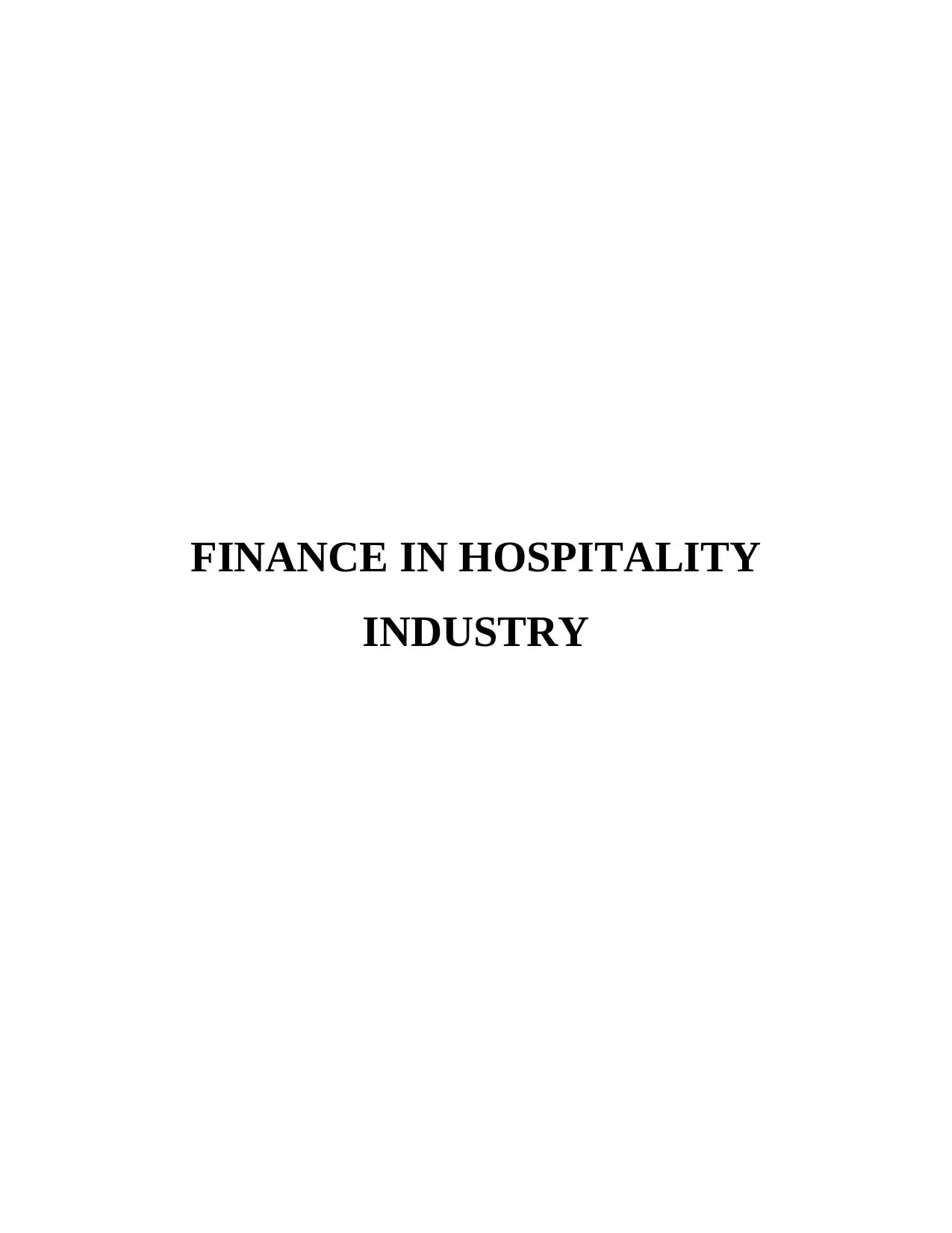
FINANCE IN HOSPITALITY
INDUSTRY
INDUSTRY
Paraphrase This Document
Need a fresh take? Get an instant paraphrase of this document with our AI Paraphraser
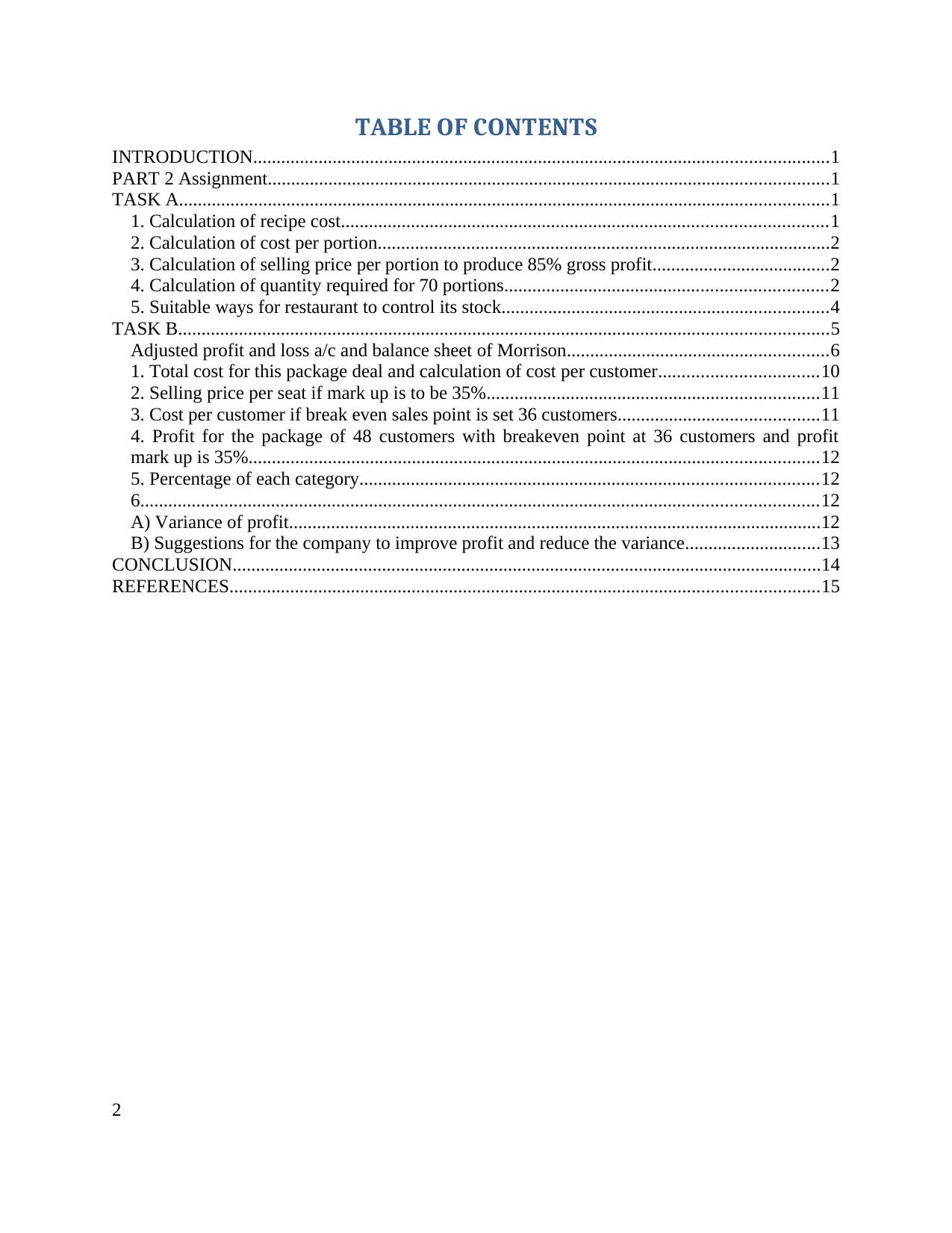
TABLE OF CONTENTS
INTRODUCTION...........................................................................................................................1
PART 2 Assignment........................................................................................................................1
TASK A...........................................................................................................................................1
1. Calculation of recipe cost........................................................................................................1
2. Calculation of cost per portion.................................................................................................2
3. Calculation of selling price per portion to produce 85% gross profit......................................2
4. Calculation of quantity required for 70 portions.....................................................................2
5. Suitable ways for restaurant to control its stock......................................................................4
TASK B...........................................................................................................................................5
Adjusted profit and loss a/c and balance sheet of Morrison........................................................6
1. Total cost for this package deal and calculation of cost per customer..................................10
2. Selling price per seat if mark up is to be 35%.......................................................................11
3. Cost per customer if break even sales point is set 36 customers...........................................11
4. Profit for the package of 48 customers with breakeven point at 36 customers and profit
mark up is 35%..........................................................................................................................12
5. Percentage of each category..................................................................................................12
6.................................................................................................................................................12
A) Variance of profit..................................................................................................................12
B) Suggestions for the company to improve profit and reduce the variance.............................13
CONCLUSION..............................................................................................................................14
REFERENCES..............................................................................................................................15
2
INTRODUCTION...........................................................................................................................1
PART 2 Assignment........................................................................................................................1
TASK A...........................................................................................................................................1
1. Calculation of recipe cost........................................................................................................1
2. Calculation of cost per portion.................................................................................................2
3. Calculation of selling price per portion to produce 85% gross profit......................................2
4. Calculation of quantity required for 70 portions.....................................................................2
5. Suitable ways for restaurant to control its stock......................................................................4
TASK B...........................................................................................................................................5
Adjusted profit and loss a/c and balance sheet of Morrison........................................................6
1. Total cost for this package deal and calculation of cost per customer..................................10
2. Selling price per seat if mark up is to be 35%.......................................................................11
3. Cost per customer if break even sales point is set 36 customers...........................................11
4. Profit for the package of 48 customers with breakeven point at 36 customers and profit
mark up is 35%..........................................................................................................................12
5. Percentage of each category..................................................................................................12
6.................................................................................................................................................12
A) Variance of profit..................................................................................................................12
B) Suggestions for the company to improve profit and reduce the variance.............................13
CONCLUSION..............................................................................................................................14
REFERENCES..............................................................................................................................15
2
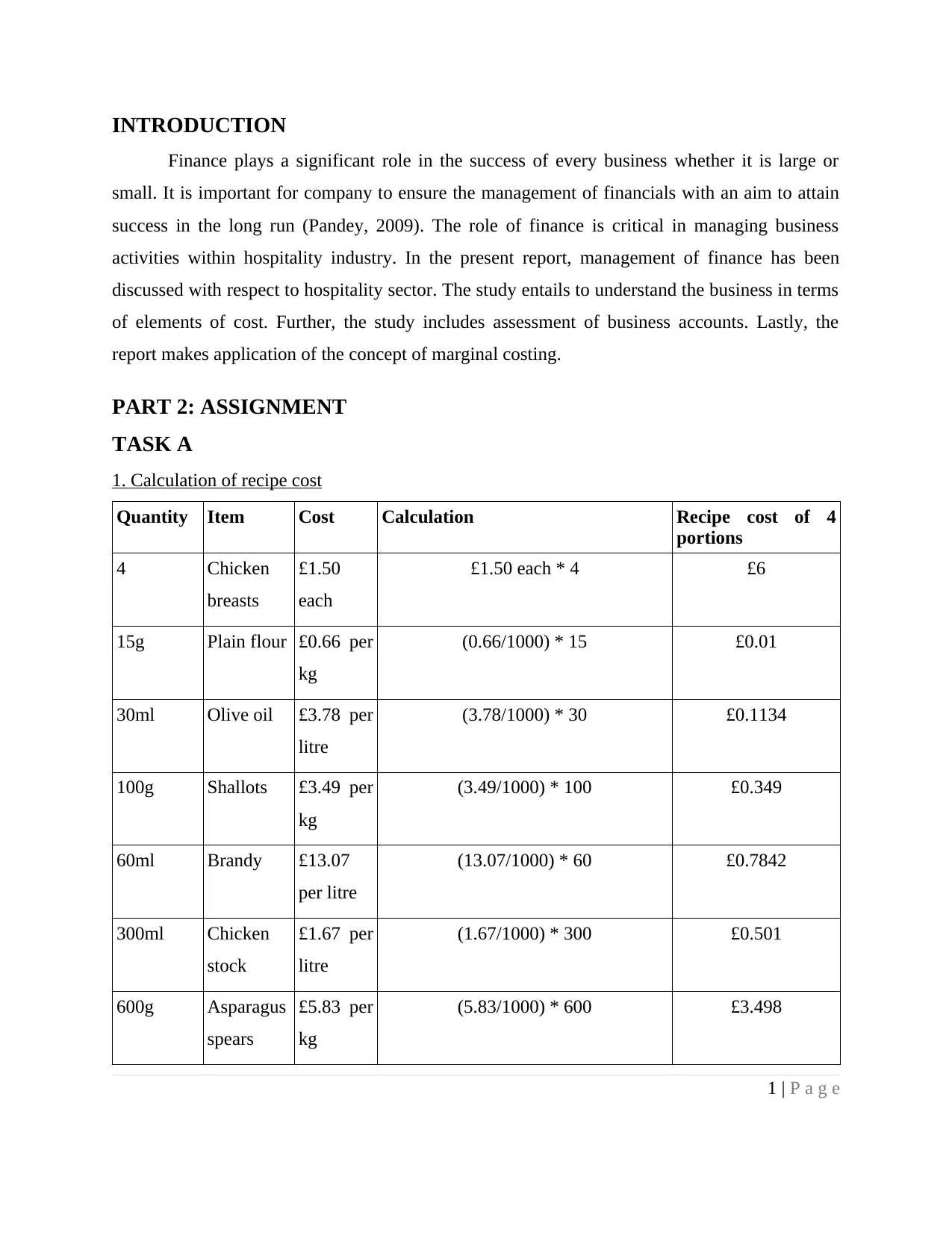
INTRODUCTION
Finance plays a significant role in the success of every business whether it is large or
small. It is important for company to ensure the management of financials with an aim to attain
success in the long run (Pandey, 2009). The role of finance is critical in managing business
activities within hospitality industry. In the present report, management of finance has been
discussed with respect to hospitality sector. The study entails to understand the business in terms
of elements of cost. Further, the study includes assessment of business accounts. Lastly, the
report makes application of the concept of marginal costing.
PART 2: ASSIGNMENT
TASK A
1. Calculation of recipe cost
Quantity Item Cost Calculation Recipe cost of 4
portions
4 Chicken
breasts
£1.50
each
£1.50 each * 4 £6
15g Plain flour £0.66 per
kg
(0.66/1000) * 15 £0.01
30ml Olive oil £3.78 per
litre
(3.78/1000) * 30 £0.1134
100g Shallots £3.49 per
kg
(3.49/1000) * 100 £0.349
60ml Brandy £13.07
per litre
(13.07/1000) * 60 £0.7842
300ml Chicken
stock
£1.67 per
litre
(1.67/1000) * 300 £0.501
600g Asparagus
spears
£5.83 per
kg
(5.83/1000) * 600 £3.498
1 | P a g e
Finance plays a significant role in the success of every business whether it is large or
small. It is important for company to ensure the management of financials with an aim to attain
success in the long run (Pandey, 2009). The role of finance is critical in managing business
activities within hospitality industry. In the present report, management of finance has been
discussed with respect to hospitality sector. The study entails to understand the business in terms
of elements of cost. Further, the study includes assessment of business accounts. Lastly, the
report makes application of the concept of marginal costing.
PART 2: ASSIGNMENT
TASK A
1. Calculation of recipe cost
Quantity Item Cost Calculation Recipe cost of 4
portions
4 Chicken
breasts
£1.50
each
£1.50 each * 4 £6
15g Plain flour £0.66 per
kg
(0.66/1000) * 15 £0.01
30ml Olive oil £3.78 per
litre
(3.78/1000) * 30 £0.1134
100g Shallots £3.49 per
kg
(3.49/1000) * 100 £0.349
60ml Brandy £13.07
per litre
(13.07/1000) * 60 £0.7842
300ml Chicken
stock
£1.67 per
litre
(1.67/1000) * 300 £0.501
600g Asparagus
spears
£5.83 per
kg
(5.83/1000) * 600 £3.498
1 | P a g e
⊘ This is a preview!⊘
Do you want full access?
Subscribe today to unlock all pages.

Trusted by 1+ million students worldwide
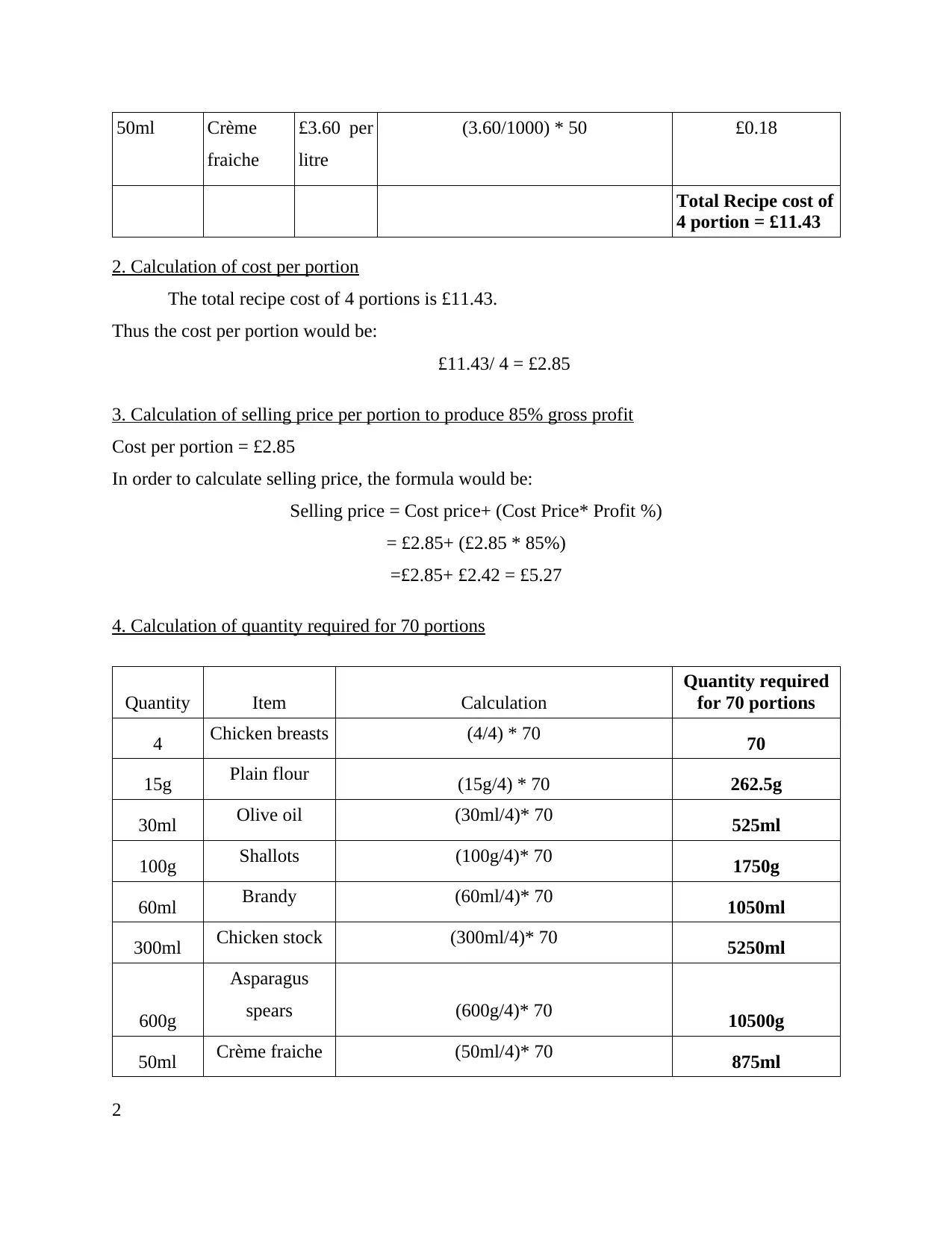
50ml Crème
fraiche
£3.60 per
litre
(3.60/1000) * 50 £0.18
Total Recipe cost of
4 portion = £11.43
2. Calculation of cost per portion
The total recipe cost of 4 portions is £11.43.
Thus the cost per portion would be:
£11.43/ 4 = £2.85
3. Calculation of selling price per portion to produce 85% gross profit
Cost per portion = £2.85
In order to calculate selling price, the formula would be:
Selling price = Cost price+ (Cost Price* Profit %)
= £2.85+ (£2.85 * 85%)
=£2.85+ £2.42 = £5.27
4. Calculation of quantity required for 70 portions
Quantity Item Calculation
Quantity required
for 70 portions
4 Chicken breasts (4/4) * 70 70
15g Plain flour (15g/4) * 70 262.5g
30ml Olive oil (30ml/4)* 70 525ml
100g Shallots (100g/4)* 70 1750g
60ml Brandy (60ml/4)* 70 1050ml
300ml Chicken stock (300ml/4)* 70 5250ml
600g
Asparagus
spears (600g/4)* 70 10500g
50ml Crème fraiche (50ml/4)* 70 875ml
2
fraiche
£3.60 per
litre
(3.60/1000) * 50 £0.18
Total Recipe cost of
4 portion = £11.43
2. Calculation of cost per portion
The total recipe cost of 4 portions is £11.43.
Thus the cost per portion would be:
£11.43/ 4 = £2.85
3. Calculation of selling price per portion to produce 85% gross profit
Cost per portion = £2.85
In order to calculate selling price, the formula would be:
Selling price = Cost price+ (Cost Price* Profit %)
= £2.85+ (£2.85 * 85%)
=£2.85+ £2.42 = £5.27
4. Calculation of quantity required for 70 portions
Quantity Item Calculation
Quantity required
for 70 portions
4 Chicken breasts (4/4) * 70 70
15g Plain flour (15g/4) * 70 262.5g
30ml Olive oil (30ml/4)* 70 525ml
100g Shallots (100g/4)* 70 1750g
60ml Brandy (60ml/4)* 70 1050ml
300ml Chicken stock (300ml/4)* 70 5250ml
600g
Asparagus
spears (600g/4)* 70 10500g
50ml Crème fraiche (50ml/4)* 70 875ml
2
Paraphrase This Document
Need a fresh take? Get an instant paraphrase of this document with our AI Paraphraser
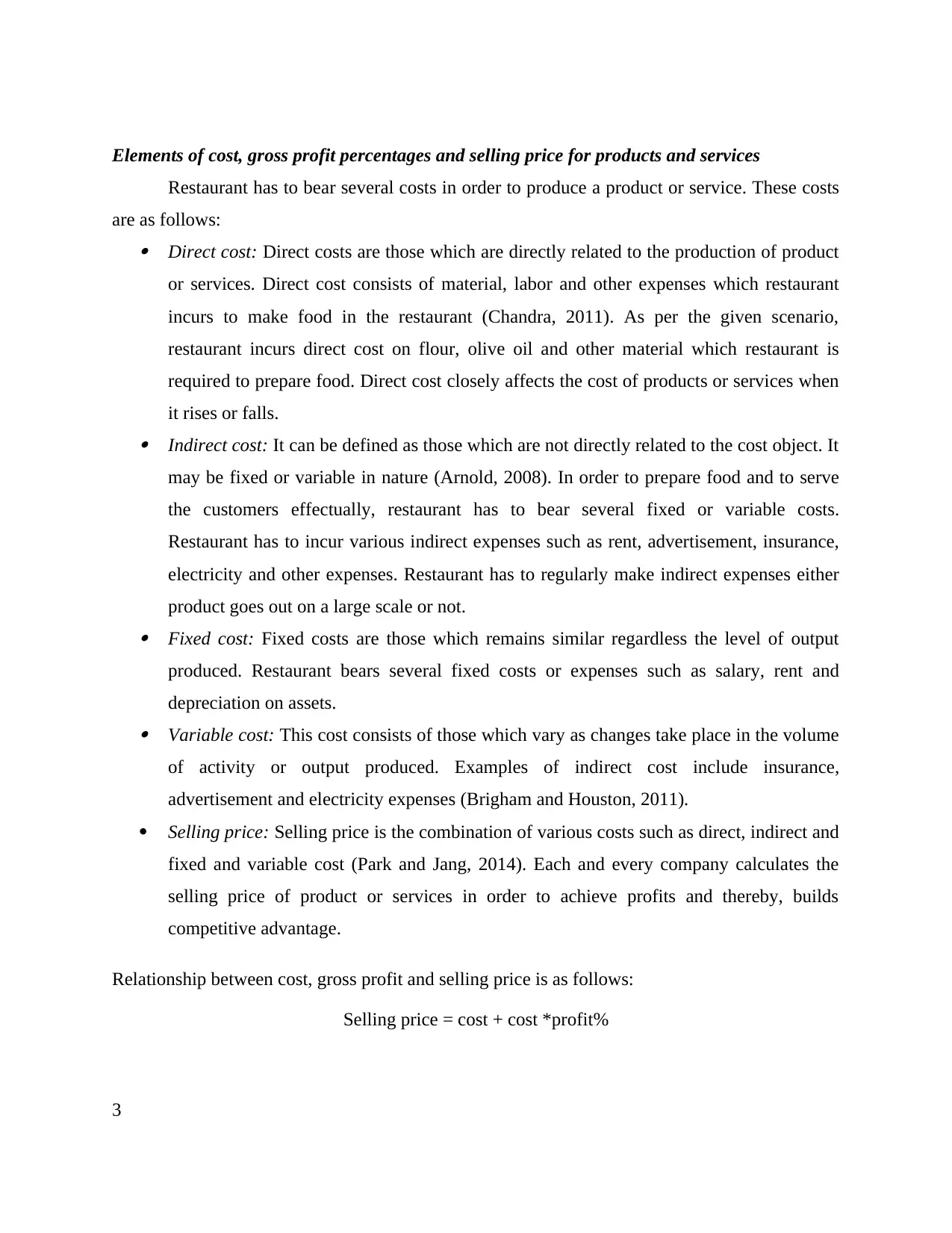
Elements of cost, gross profit percentages and selling price for products and services
Restaurant has to bear several costs in order to produce a product or service. These costs
are as follows: Direct cost: Direct costs are those which are directly related to the production of product
or services. Direct cost consists of material, labor and other expenses which restaurant
incurs to make food in the restaurant (Chandra, 2011). As per the given scenario,
restaurant incurs direct cost on flour, olive oil and other material which restaurant is
required to prepare food. Direct cost closely affects the cost of products or services when
it rises or falls. Indirect cost: It can be defined as those which are not directly related to the cost object. It
may be fixed or variable in nature (Arnold, 2008). In order to prepare food and to serve
the customers effectually, restaurant has to bear several fixed or variable costs.
Restaurant has to incur various indirect expenses such as rent, advertisement, insurance,
electricity and other expenses. Restaurant has to regularly make indirect expenses either
product goes out on a large scale or not. Fixed cost: Fixed costs are those which remains similar regardless the level of output
produced. Restaurant bears several fixed costs or expenses such as salary, rent and
depreciation on assets. Variable cost: This cost consists of those which vary as changes take place in the volume
of activity or output produced. Examples of indirect cost include insurance,
advertisement and electricity expenses (Brigham and Houston, 2011).
Selling price: Selling price is the combination of various costs such as direct, indirect and
fixed and variable cost (Park and Jang, 2014). Each and every company calculates the
selling price of product or services in order to achieve profits and thereby, builds
competitive advantage.
Relationship between cost, gross profit and selling price is as follows:
Selling price = cost + cost *profit%
3
Restaurant has to bear several costs in order to produce a product or service. These costs
are as follows: Direct cost: Direct costs are those which are directly related to the production of product
or services. Direct cost consists of material, labor and other expenses which restaurant
incurs to make food in the restaurant (Chandra, 2011). As per the given scenario,
restaurant incurs direct cost on flour, olive oil and other material which restaurant is
required to prepare food. Direct cost closely affects the cost of products or services when
it rises or falls. Indirect cost: It can be defined as those which are not directly related to the cost object. It
may be fixed or variable in nature (Arnold, 2008). In order to prepare food and to serve
the customers effectually, restaurant has to bear several fixed or variable costs.
Restaurant has to incur various indirect expenses such as rent, advertisement, insurance,
electricity and other expenses. Restaurant has to regularly make indirect expenses either
product goes out on a large scale or not. Fixed cost: Fixed costs are those which remains similar regardless the level of output
produced. Restaurant bears several fixed costs or expenses such as salary, rent and
depreciation on assets. Variable cost: This cost consists of those which vary as changes take place in the volume
of activity or output produced. Examples of indirect cost include insurance,
advertisement and electricity expenses (Brigham and Houston, 2011).
Selling price: Selling price is the combination of various costs such as direct, indirect and
fixed and variable cost (Park and Jang, 2014). Each and every company calculates the
selling price of product or services in order to achieve profits and thereby, builds
competitive advantage.
Relationship between cost, gross profit and selling price is as follows:
Selling price = cost + cost *profit%
3
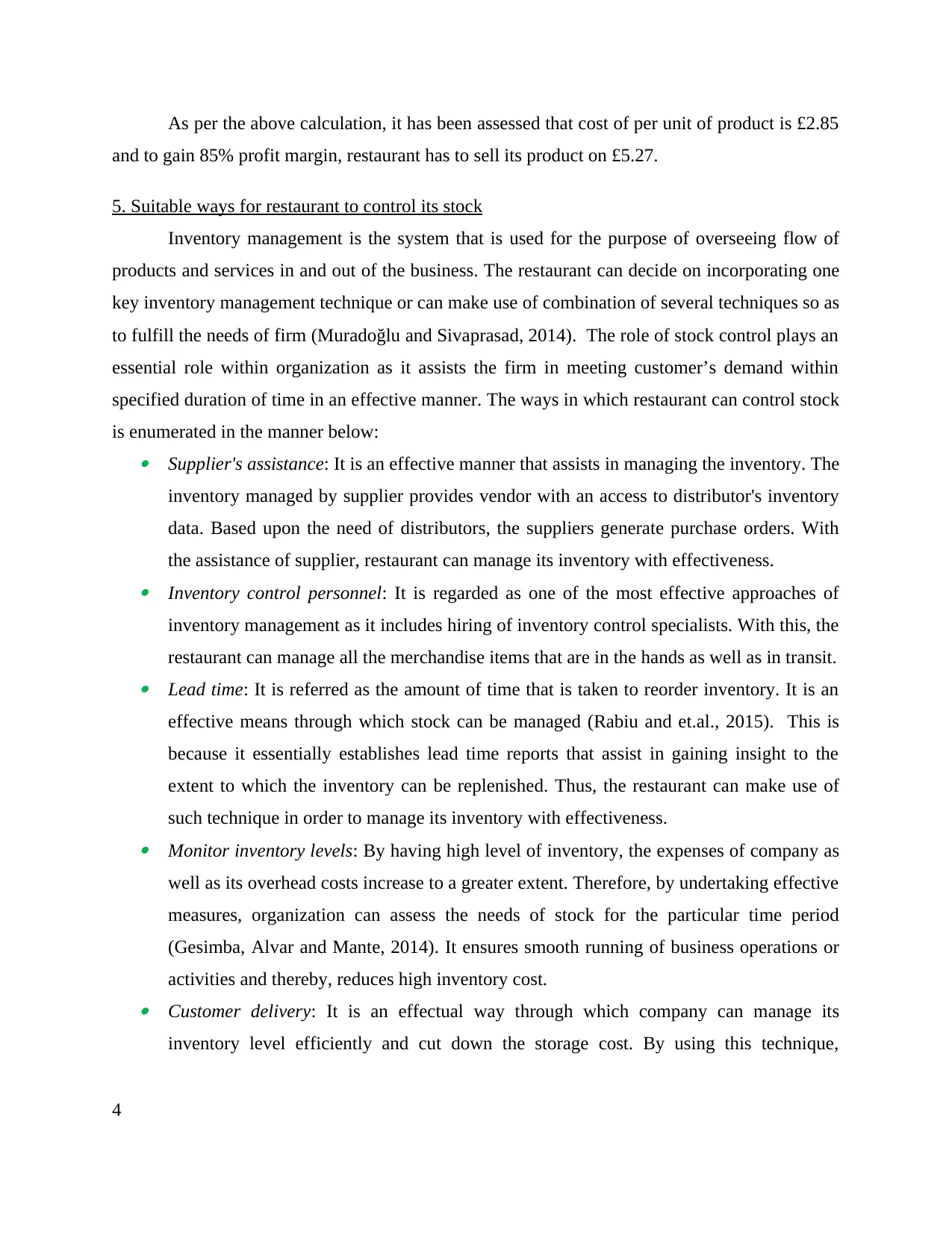
As per the above calculation, it has been assessed that cost of per unit of product is £2.85
and to gain 85% profit margin, restaurant has to sell its product on £5.27.
5. Suitable ways for restaurant to control its stock
Inventory management is the system that is used for the purpose of overseeing flow of
products and services in and out of the business. The restaurant can decide on incorporating one
key inventory management technique or can make use of combination of several techniques so as
to fulfill the needs of firm (Muradoğlu and Sivaprasad, 2014). The role of stock control plays an
essential role within organization as it assists the firm in meeting customer’s demand within
specified duration of time in an effective manner. The ways in which restaurant can control stock
is enumerated in the manner below: Supplier's assistance: It is an effective manner that assists in managing the inventory. The
inventory managed by supplier provides vendor with an access to distributor's inventory
data. Based upon the need of distributors, the suppliers generate purchase orders. With
the assistance of supplier, restaurant can manage its inventory with effectiveness. Inventory control personnel: It is regarded as one of the most effective approaches of
inventory management as it includes hiring of inventory control specialists. With this, the
restaurant can manage all the merchandise items that are in the hands as well as in transit. Lead time: It is referred as the amount of time that is taken to reorder inventory. It is an
effective means through which stock can be managed (Rabiu and et.al., 2015). This is
because it essentially establishes lead time reports that assist in gaining insight to the
extent to which the inventory can be replenished. Thus, the restaurant can make use of
such technique in order to manage its inventory with effectiveness. Monitor inventory levels: By having high level of inventory, the expenses of company as
well as its overhead costs increase to a greater extent. Therefore, by undertaking effective
measures, organization can assess the needs of stock for the particular time period
(Gesimba, Alvar and Mante, 2014). It ensures smooth running of business operations or
activities and thereby, reduces high inventory cost. Customer delivery: It is an effectual way through which company can manage its
inventory level efficiently and cut down the storage cost. By using this technique,
4
and to gain 85% profit margin, restaurant has to sell its product on £5.27.
5. Suitable ways for restaurant to control its stock
Inventory management is the system that is used for the purpose of overseeing flow of
products and services in and out of the business. The restaurant can decide on incorporating one
key inventory management technique or can make use of combination of several techniques so as
to fulfill the needs of firm (Muradoğlu and Sivaprasad, 2014). The role of stock control plays an
essential role within organization as it assists the firm in meeting customer’s demand within
specified duration of time in an effective manner. The ways in which restaurant can control stock
is enumerated in the manner below: Supplier's assistance: It is an effective manner that assists in managing the inventory. The
inventory managed by supplier provides vendor with an access to distributor's inventory
data. Based upon the need of distributors, the suppliers generate purchase orders. With
the assistance of supplier, restaurant can manage its inventory with effectiveness. Inventory control personnel: It is regarded as one of the most effective approaches of
inventory management as it includes hiring of inventory control specialists. With this, the
restaurant can manage all the merchandise items that are in the hands as well as in transit. Lead time: It is referred as the amount of time that is taken to reorder inventory. It is an
effective means through which stock can be managed (Rabiu and et.al., 2015). This is
because it essentially establishes lead time reports that assist in gaining insight to the
extent to which the inventory can be replenished. Thus, the restaurant can make use of
such technique in order to manage its inventory with effectiveness. Monitor inventory levels: By having high level of inventory, the expenses of company as
well as its overhead costs increase to a greater extent. Therefore, by undertaking effective
measures, organization can assess the needs of stock for the particular time period
(Gesimba, Alvar and Mante, 2014). It ensures smooth running of business operations or
activities and thereby, reduces high inventory cost. Customer delivery: It is an effectual way through which company can manage its
inventory level efficiently and cut down the storage cost. By using this technique,
4
⊘ This is a preview!⊘
Do you want full access?
Subscribe today to unlock all pages.

Trusted by 1+ million students worldwide
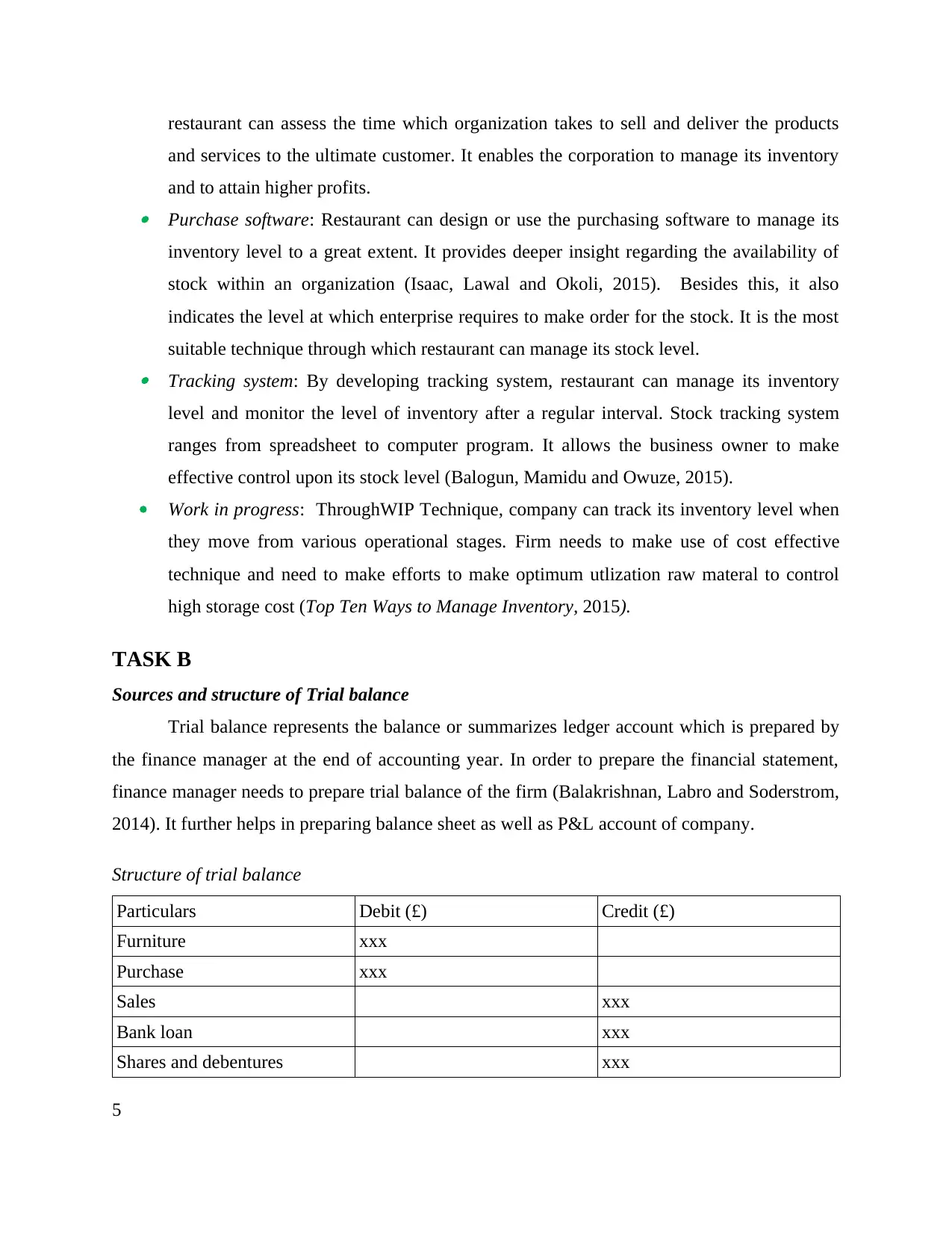
restaurant can assess the time which organization takes to sell and deliver the products
and services to the ultimate customer. It enables the corporation to manage its inventory
and to attain higher profits. Purchase software: Restaurant can design or use the purchasing software to manage its
inventory level to a great extent. It provides deeper insight regarding the availability of
stock within an organization (Isaac, Lawal and Okoli, 2015). Besides this, it also
indicates the level at which enterprise requires to make order for the stock. It is the most
suitable technique through which restaurant can manage its stock level. Tracking system: By developing tracking system, restaurant can manage its inventory
level and monitor the level of inventory after a regular interval. Stock tracking system
ranges from spreadsheet to computer program. It allows the business owner to make
effective control upon its stock level (Balogun, Mamidu and Owuze, 2015).
Work in progress: ThroughWIP Technique, company can track its inventory level when
they move from various operational stages. Firm needs to make use of cost effective
technique and need to make efforts to make optimum utlization raw materal to control
high storage cost (Top Ten Ways to Manage Inventory, 2015).
TASK B
Sources and structure of Trial balance
Trial balance represents the balance or summarizes ledger account which is prepared by
the finance manager at the end of accounting year. In order to prepare the financial statement,
finance manager needs to prepare trial balance of the firm (Balakrishnan, Labro and Soderstrom,
2014). It further helps in preparing balance sheet as well as P&L account of company.
Structure of trial balance
Particulars Debit (£) Credit (£)
Furniture xxx
Purchase xxx
Sales xxx
Bank loan xxx
Shares and debentures xxx
5
and services to the ultimate customer. It enables the corporation to manage its inventory
and to attain higher profits. Purchase software: Restaurant can design or use the purchasing software to manage its
inventory level to a great extent. It provides deeper insight regarding the availability of
stock within an organization (Isaac, Lawal and Okoli, 2015). Besides this, it also
indicates the level at which enterprise requires to make order for the stock. It is the most
suitable technique through which restaurant can manage its stock level. Tracking system: By developing tracking system, restaurant can manage its inventory
level and monitor the level of inventory after a regular interval. Stock tracking system
ranges from spreadsheet to computer program. It allows the business owner to make
effective control upon its stock level (Balogun, Mamidu and Owuze, 2015).
Work in progress: ThroughWIP Technique, company can track its inventory level when
they move from various operational stages. Firm needs to make use of cost effective
technique and need to make efforts to make optimum utlization raw materal to control
high storage cost (Top Ten Ways to Manage Inventory, 2015).
TASK B
Sources and structure of Trial balance
Trial balance represents the balance or summarizes ledger account which is prepared by
the finance manager at the end of accounting year. In order to prepare the financial statement,
finance manager needs to prepare trial balance of the firm (Balakrishnan, Labro and Soderstrom,
2014). It further helps in preparing balance sheet as well as P&L account of company.
Structure of trial balance
Particulars Debit (£) Credit (£)
Furniture xxx
Purchase xxx
Sales xxx
Bank loan xxx
Shares and debentures xxx
5
Paraphrase This Document
Need a fresh take? Get an instant paraphrase of this document with our AI Paraphraser
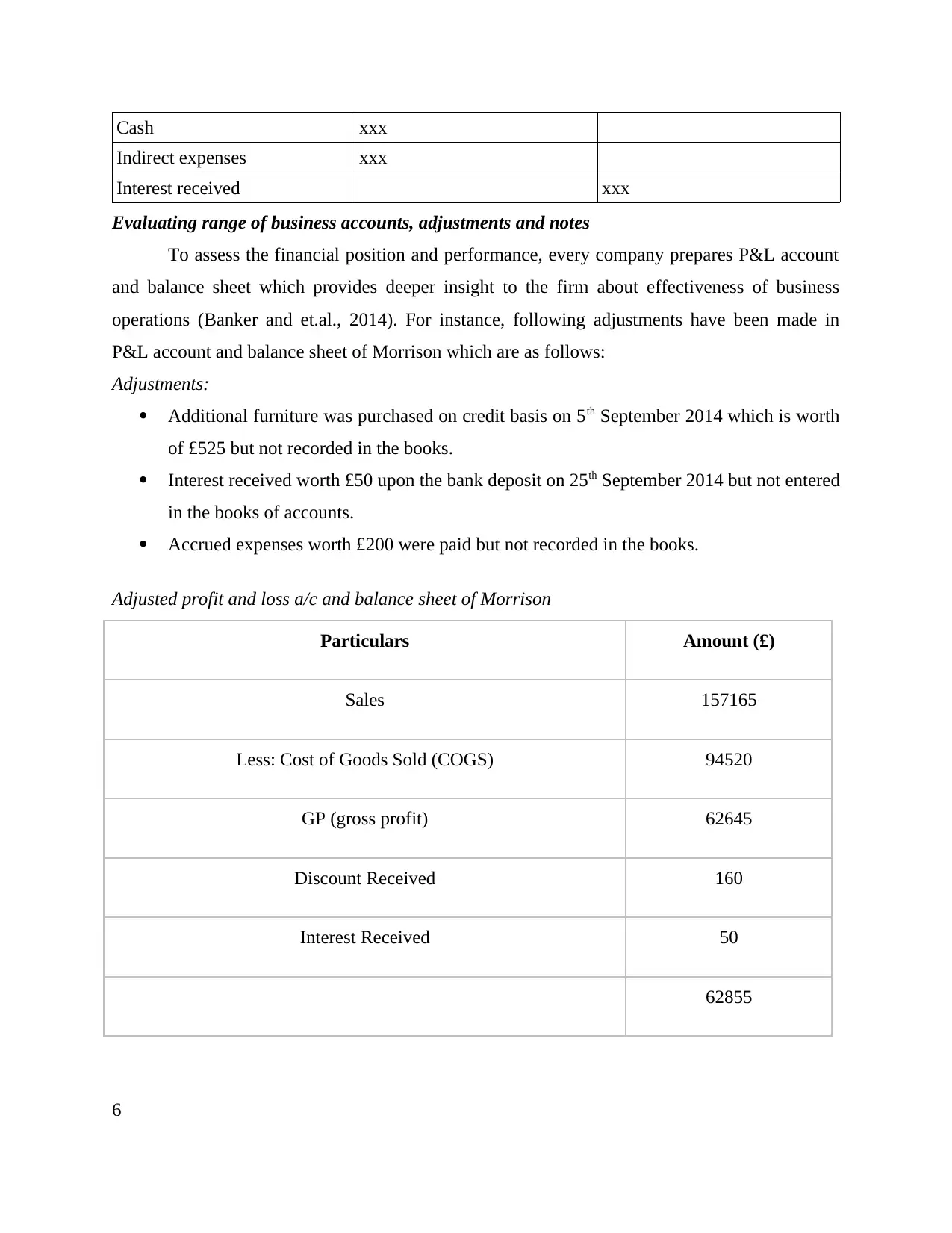
Cash xxx
Indirect expenses xxx
Interest received xxx
Evaluating range of business accounts, adjustments and notes
To assess the financial position and performance, every company prepares P&L account
and balance sheet which provides deeper insight to the firm about effectiveness of business
operations (Banker and et.al., 2014). For instance, following adjustments have been made in
P&L account and balance sheet of Morrison which are as follows:
Adjustments:
Additional furniture was purchased on credit basis on 5th September 2014 which is worth
of £525 but not recorded in the books.
Interest received worth £50 upon the bank deposit on 25th September 2014 but not entered
in the books of accounts.
Accrued expenses worth £200 were paid but not recorded in the books.
Adjusted profit and loss a/c and balance sheet of Morrison
Particulars Amount (£)
Sales 157165
Less: Cost of Goods Sold (COGS) 94520
GP (gross profit) 62645
Discount Received 160
Interest Received 50
62855
6
Indirect expenses xxx
Interest received xxx
Evaluating range of business accounts, adjustments and notes
To assess the financial position and performance, every company prepares P&L account
and balance sheet which provides deeper insight to the firm about effectiveness of business
operations (Banker and et.al., 2014). For instance, following adjustments have been made in
P&L account and balance sheet of Morrison which are as follows:
Adjustments:
Additional furniture was purchased on credit basis on 5th September 2014 which is worth
of £525 but not recorded in the books.
Interest received worth £50 upon the bank deposit on 25th September 2014 but not entered
in the books of accounts.
Accrued expenses worth £200 were paid but not recorded in the books.
Adjusted profit and loss a/c and balance sheet of Morrison
Particulars Amount (£)
Sales 157165
Less: Cost of Goods Sold (COGS) 94520
GP (gross profit) 62645
Discount Received 160
Interest Received 50
62855
6
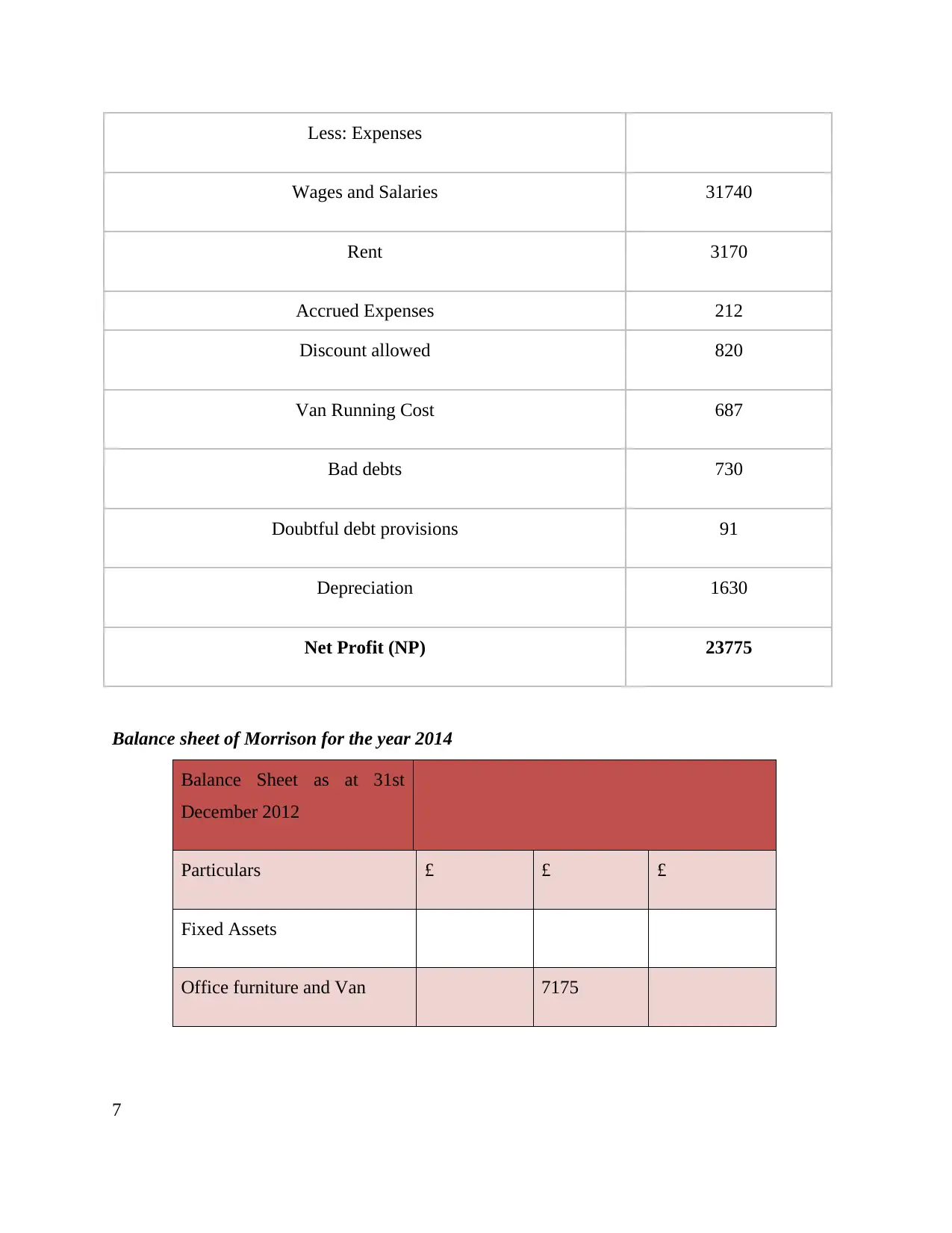
Less: Expenses
Wages and Salaries 31740
Rent 3170
Accrued Expenses 212
Discount allowed 820
Van Running Cost 687
Bad debts 730
Doubtful debt provisions 91
Depreciation 1630
Net Profit (NP) 23775
Balance sheet of Morrison for the year 2014
Balance Sheet as at 31st
December 2012
Particulars £ £ £
Fixed Assets
Office furniture and Van 7175
7
Wages and Salaries 31740
Rent 3170
Accrued Expenses 212
Discount allowed 820
Van Running Cost 687
Bad debts 730
Doubtful debt provisions 91
Depreciation 1630
Net Profit (NP) 23775
Balance sheet of Morrison for the year 2014
Balance Sheet as at 31st
December 2012
Particulars £ £ £
Fixed Assets
Office furniture and Van 7175
7
⊘ This is a preview!⊘
Do you want full access?
Subscribe today to unlock all pages.

Trusted by 1+ million students worldwide
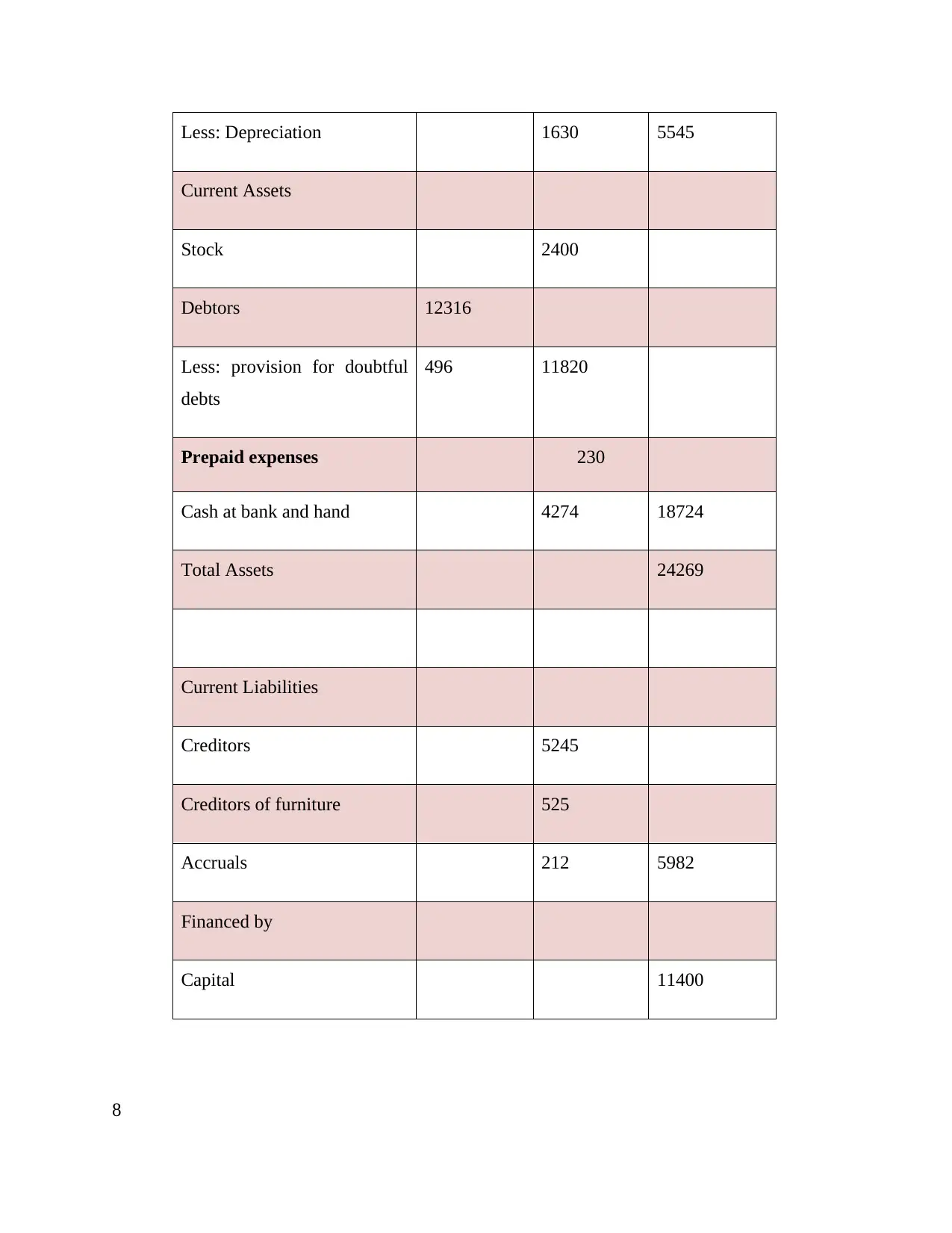
Less: Depreciation 1630 5545
Current Assets
Stock 2400
Debtors 12316
Less: provision for doubtful
debts
496 11820
Prepaid expenses 230
Cash at bank and hand 4274 18724
Total Assets 24269
Current Liabilities
Creditors 5245
Creditors of furniture 525
Accruals 212 5982
Financed by
Capital 11400
8
Current Assets
Stock 2400
Debtors 12316
Less: provision for doubtful
debts
496 11820
Prepaid expenses 230
Cash at bank and hand 4274 18724
Total Assets 24269
Current Liabilities
Creditors 5245
Creditors of furniture 525
Accruals 212 5982
Financed by
Capital 11400
8
Paraphrase This Document
Need a fresh take? Get an instant paraphrase of this document with our AI Paraphraser
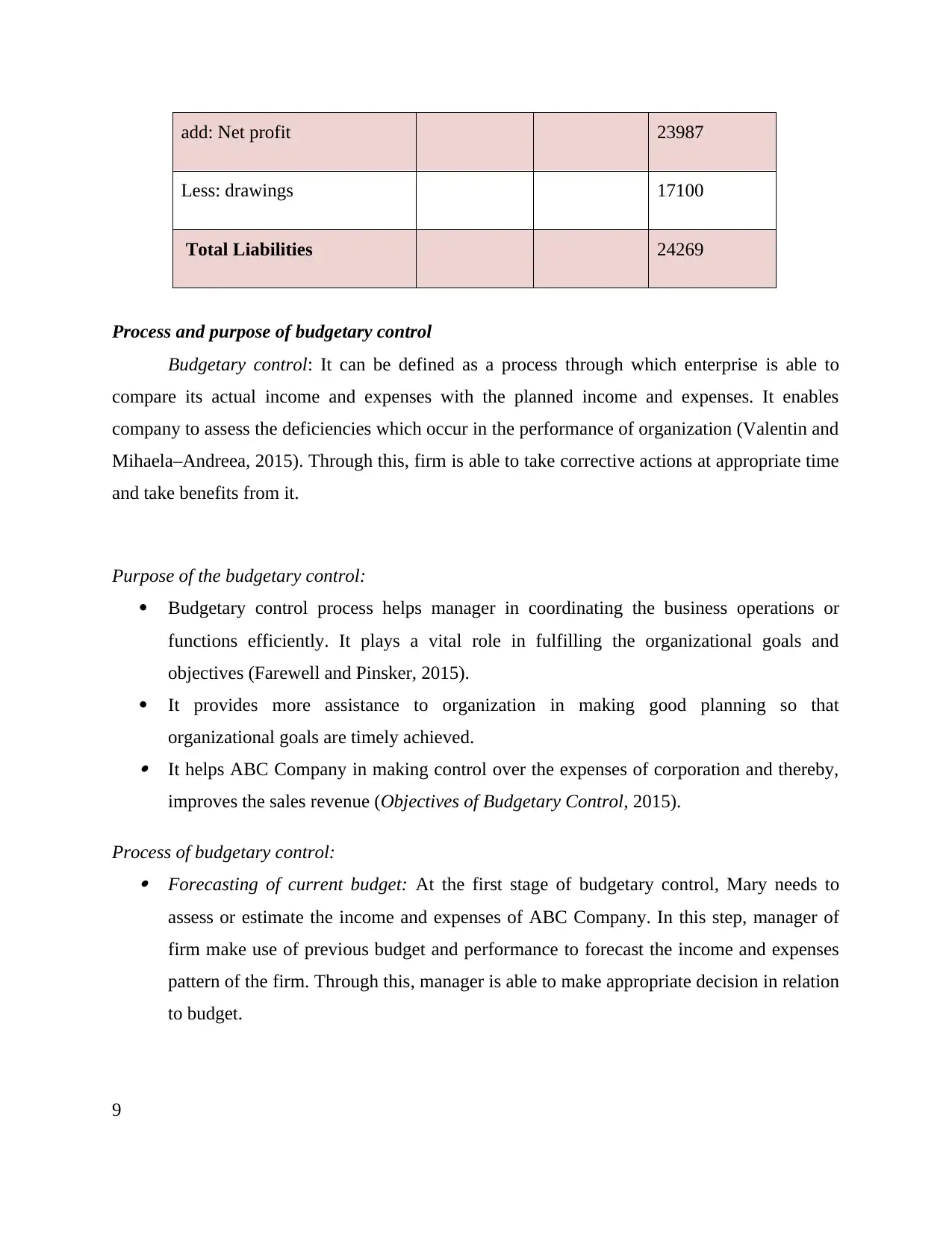
add: Net profit 23987
Less: drawings 17100
Total Liabilities 24269
Process and purpose of budgetary control
Budgetary control: It can be defined as a process through which enterprise is able to
compare its actual income and expenses with the planned income and expenses. It enables
company to assess the deficiencies which occur in the performance of organization (Valentin and
Mihaela–Andreea, 2015). Through this, firm is able to take corrective actions at appropriate time
and take benefits from it.
Purpose of the budgetary control:
Budgetary control process helps manager in coordinating the business operations or
functions efficiently. It plays a vital role in fulfilling the organizational goals and
objectives (Farewell and Pinsker, 2015).
It provides more assistance to organization in making good planning so that
organizational goals are timely achieved. It helps ABC Company in making control over the expenses of corporation and thereby,
improves the sales revenue (Objectives of Budgetary Control, 2015).
Process of budgetary control: Forecasting of current budget: At the first stage of budgetary control, Mary needs to
assess or estimate the income and expenses of ABC Company. In this step, manager of
firm make use of previous budget and performance to forecast the income and expenses
pattern of the firm. Through this, manager is able to make appropriate decision in relation
to budget.
9
Less: drawings 17100
Total Liabilities 24269
Process and purpose of budgetary control
Budgetary control: It can be defined as a process through which enterprise is able to
compare its actual income and expenses with the planned income and expenses. It enables
company to assess the deficiencies which occur in the performance of organization (Valentin and
Mihaela–Andreea, 2015). Through this, firm is able to take corrective actions at appropriate time
and take benefits from it.
Purpose of the budgetary control:
Budgetary control process helps manager in coordinating the business operations or
functions efficiently. It plays a vital role in fulfilling the organizational goals and
objectives (Farewell and Pinsker, 2015).
It provides more assistance to organization in making good planning so that
organizational goals are timely achieved. It helps ABC Company in making control over the expenses of corporation and thereby,
improves the sales revenue (Objectives of Budgetary Control, 2015).
Process of budgetary control: Forecasting of current budget: At the first stage of budgetary control, Mary needs to
assess or estimate the income and expenses of ABC Company. In this step, manager of
firm make use of previous budget and performance to forecast the income and expenses
pattern of the firm. Through this, manager is able to make appropriate decision in relation
to budget.
9
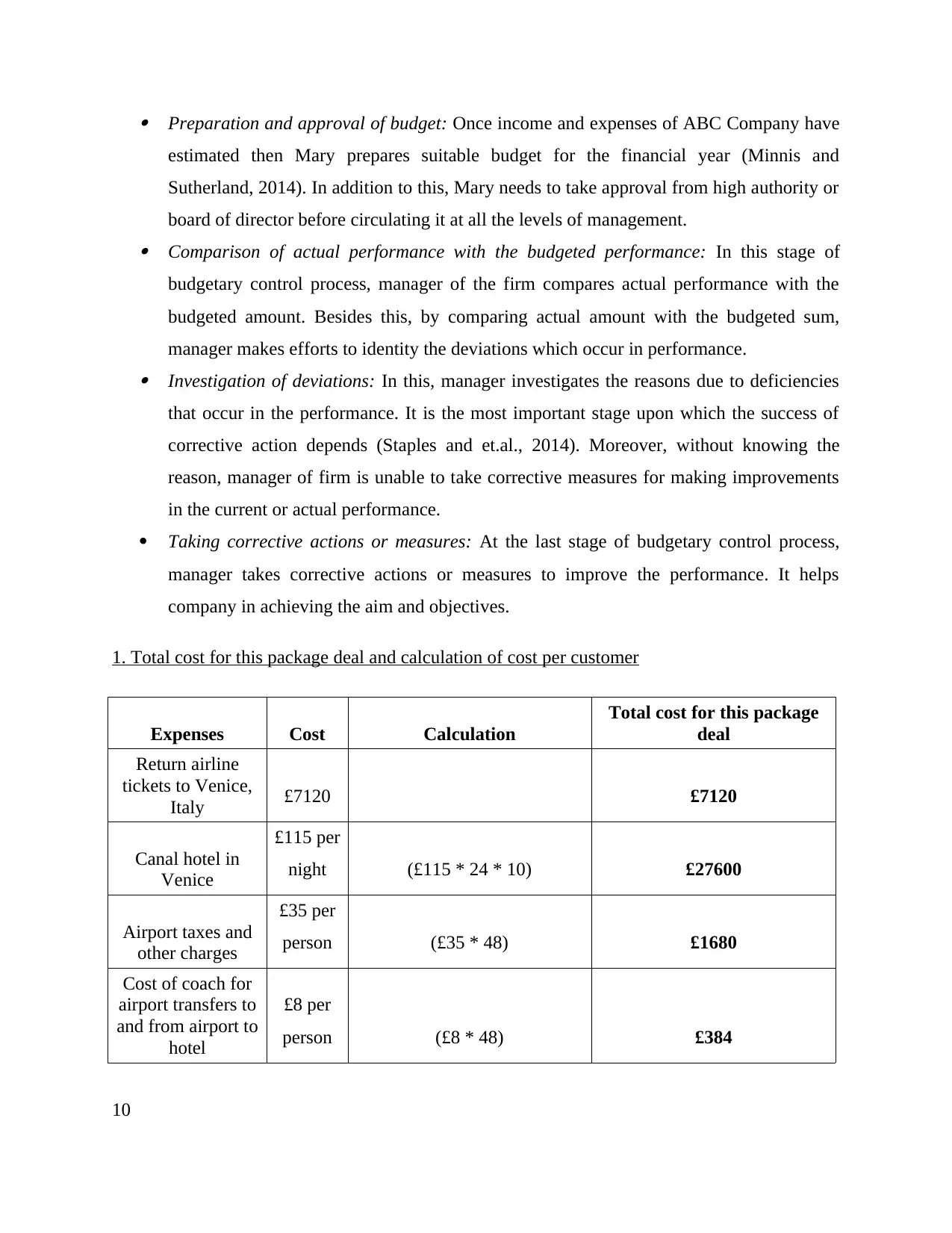
Preparation and approval of budget: Once income and expenses of ABC Company have
estimated then Mary prepares suitable budget for the financial year (Minnis and
Sutherland, 2014). In addition to this, Mary needs to take approval from high authority or
board of director before circulating it at all the levels of management. Comparison of actual performance with the budgeted performance: In this stage of
budgetary control process, manager of the firm compares actual performance with the
budgeted amount. Besides this, by comparing actual amount with the budgeted sum,
manager makes efforts to identity the deviations which occur in performance. Investigation of deviations: In this, manager investigates the reasons due to deficiencies
that occur in the performance. It is the most important stage upon which the success of
corrective action depends (Staples and et.al., 2014). Moreover, without knowing the
reason, manager of firm is unable to take corrective measures for making improvements
in the current or actual performance.
Taking corrective actions or measures: At the last stage of budgetary control process,
manager takes corrective actions or measures to improve the performance. It helps
company in achieving the aim and objectives.
1. Total cost for this package deal and calculation of cost per customer
Expenses Cost Calculation
Total cost for this package
deal
Return airline
tickets to Venice,
Italy £7120 £7120
Canal hotel in
Venice
£115 per
night (£115 * 24 * 10) £27600
Airport taxes and
other charges
£35 per
person (£35 * 48) £1680
Cost of coach for
airport transfers to
and from airport to
hotel
£8 per
person (£8 * 48) £384
10
estimated then Mary prepares suitable budget for the financial year (Minnis and
Sutherland, 2014). In addition to this, Mary needs to take approval from high authority or
board of director before circulating it at all the levels of management. Comparison of actual performance with the budgeted performance: In this stage of
budgetary control process, manager of the firm compares actual performance with the
budgeted amount. Besides this, by comparing actual amount with the budgeted sum,
manager makes efforts to identity the deviations which occur in performance. Investigation of deviations: In this, manager investigates the reasons due to deficiencies
that occur in the performance. It is the most important stage upon which the success of
corrective action depends (Staples and et.al., 2014). Moreover, without knowing the
reason, manager of firm is unable to take corrective measures for making improvements
in the current or actual performance.
Taking corrective actions or measures: At the last stage of budgetary control process,
manager takes corrective actions or measures to improve the performance. It helps
company in achieving the aim and objectives.
1. Total cost for this package deal and calculation of cost per customer
Expenses Cost Calculation
Total cost for this package
deal
Return airline
tickets to Venice,
Italy £7120 £7120
Canal hotel in
Venice
£115 per
night (£115 * 24 * 10) £27600
Airport taxes and
other charges
£35 per
person (£35 * 48) £1680
Cost of coach for
airport transfers to
and from airport to
hotel
£8 per
person (£8 * 48) £384
10
⊘ This is a preview!⊘
Do you want full access?
Subscribe today to unlock all pages.

Trusted by 1+ million students worldwide
1 out of 17
Your All-in-One AI-Powered Toolkit for Academic Success.
+13062052269
info@desklib.com
Available 24*7 on WhatsApp / Email
![[object Object]](/_next/static/media/star-bottom.7253800d.svg)
Unlock your academic potential
Copyright © 2020–2025 A2Z Services. All Rights Reserved. Developed and managed by ZUCOL.


